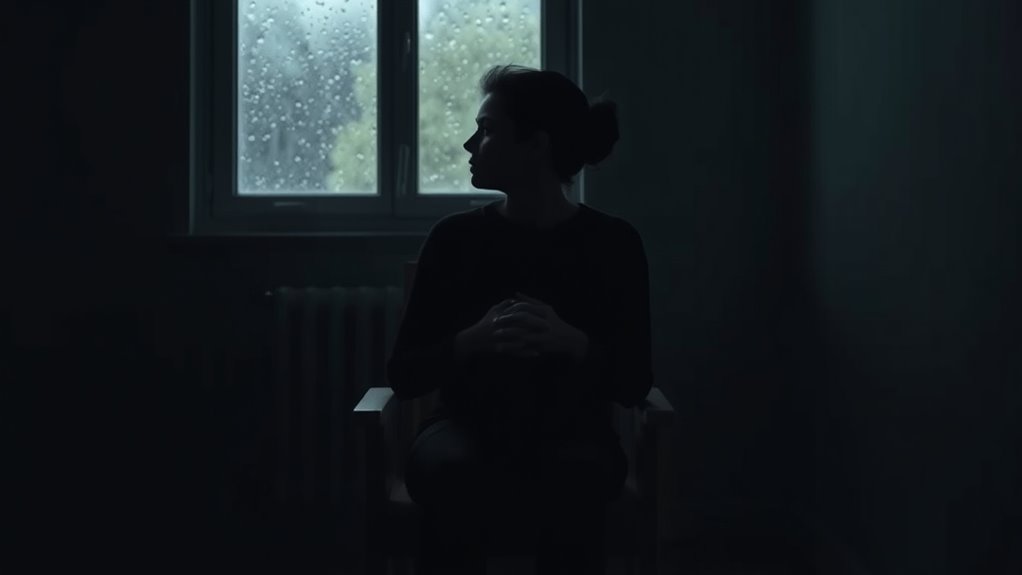Choosing between low-contact and no-contact with a BPD mother depends on your emotional needs and safety. Low-contact limits interactions to protect your mental health while still keeping some connection, but it requires effort and might bring guilt. No-contact offers complete emotional safety and space to heal, yet it can feel lonely. Understanding the benefits and challenges of each approach can help you decide the best way to care for yourself now. Continue exploring to find what fits your situation best.
Key Takeaways
- Low-contact limits interactions and maintains some connection, while no-contact involves complete emotional and physical separation.
- Low-contact allows setting boundaries to reduce overwhelm; no-contact removes all contact to prevent ongoing harm.
- Low-contact requires ongoing effort to enforce boundaries; no-contact offers clear, definitive separation for healing.
- Low-contact may cause feelings of guilt or relational tension; no-contact may evoke loneliness but prioritizes emotional safety.
- Choice depends on individual resilience, safety needs, and relationship dynamics, balancing protection with emotional well-being.

Deciding how to interact with a mother who has borderline personality disorder (BPD) can be challenging, as it directly impacts your emotional well-being. You might feel pulled between wanting to maintain some connection and protecting yourself from her unpredictable behaviors. Low-contact and no-contact strategies each have their own advantages and drawbacks, and choosing between them depends on your specific circumstances and boundaries.
With low-contact, you decide to limit your interactions to protect your mental health while still keeping a connection. This approach allows you to set clear boundaries, such as reducing visits or phone calls, so that you’re not overwhelmed by her emotional swings. It offers a way to preserve some relationship without putting yourself at constant risk of emotional harm. You might communicate that you’re available for important moments or emergencies, but otherwise, you prioritize your own stability. This balance helps you avoid feelings of guilt while maintaining a sense of compassion or duty.
Limiting interactions to protect your mental health while maintaining some connection.
However, low-contact isn’t foolproof. It requires ongoing effort to enforce boundaries and resist the temptation to engage in damaging conversations or emotional manipulation. You may find yourself feeling guilty or conflicted about pulling back, especially if your mother’s behavior is intense or if you fear damaging the relationship entirely. It’s also possible that her reactions to your limited contact could be hurtful or manipulative, which can make maintaining boundaries difficult. Still, for many, low-contact offers a manageable way to keep some connection without sacrificing their well-being.
On the other hand, choosing no-contact means cutting ties entirely, at least temporarily or permanently. This decision is often driven by the need to protect yourself from ongoing emotional harm, manipulation, or abuse. If interactions with your mother leave you feeling drained, anxious, or unsafe, going no-contact might be the healthiest choice. It provides a clear boundary that removes the possibility of emotional triggers or conflicts. You focus on healing, building your own life, and establishing healthier relationships.
That said, no-contact isn’t easy. It can evoke feelings of guilt, grief, or loneliness, especially if you still love or miss her. People might judge you or question your decision, but ultimately, your mental health comes first. Going no-contact doesn’t mean you forget her or stop caring; it’s about prioritizing your emotional safety. It can also bring relief and clarity, allowing you to regain control over your life and reduce ongoing stress.
Both approaches require self-awareness and honesty about what you can handle. Whether you choose low-contact or no-contact, the goal is to foster your well-being while steering through the complex reality of a relationship with a mother who has BPD.
Frequently Asked Questions
How Do I Determine if Low- or No-Contact Is Right for Me?
You should consider low- or no-contact if interactions with your mother cause emotional harm, stress, or hinder your well-being. Reflect on how her behavior affects you and whether boundaries help or worsen the situation. Trust your feelings and prioritize your mental health. Consulting a therapist can offer clarity and guidance, helping you decide which approach best supports your needs and safety in maintaining your emotional stability.
Can Boundaries Improve My Relationship With a BPD Mother?
Boundaries can definitely improve your relationship with a BPD mother by protecting your emotional well-being and setting clear expectations. When you establish firm limits, you create a space for healthier interactions and reduce misunderstandings. Consistently enforcing these boundaries helps her understand your needs, which can foster respect and stability. While boundaries won’t fix everything, they give you control and support a more balanced relationship.
What Are Signs of Emotional Safety in Contact Decisions?
You’ll notice emotional safety when you feel respected, heard, and free from manipulation or guilt. If your interactions leave you feeling calmer, more secure, and able to set boundaries without fear, it’s a good sign. When you trust your reactions and don’t feel overwhelmed or anxious afterward, that indicates healthy contact. Trust your intuition—if contact consistently feels safe and supportive, it’s a positive sign for your well-being.
How Can I Cope With Guilt After Choosing No-Contact?
You can cope with guilt by reminding yourself that prioritizing your mental health is essential. Acknowledge your feelings without judgment and validate your decision as necessary for your well-being. Focus on self-care, seek support from trusted friends or a therapist, and practice compassion for yourself. Remember, setting boundaries is a sign of strength, not failure, and it’s okay to prioritize your safety and peace over guilt.
Are There Support Groups for Children of BPD Mothers?
Yes, there are support groups for children of BPD mothers. Many offer online communities where you can connect anonymously and find understanding from others who’ve faced similar challenges. You might worry about opening up, but these groups provide a safe space to share experiences, gain insights, and build resilience. Joining can remind you you’re not alone, helping you heal and find strength in community.
Conclusion
Deciding between low-contact and no-contact with a BPD mother is deeply personal. Research shows that about 60% of adult children report ongoing emotional distress, regardless of the level of contact. Ultimately, prioritize your mental health and boundaries. Whether you choose limited interaction or complete cut-off, trust your instincts. Remember, protecting your well-being isn’t selfish—it’s essential for healing and growth. Your path is unique, and no choice is wrong if it fosters your peace.









